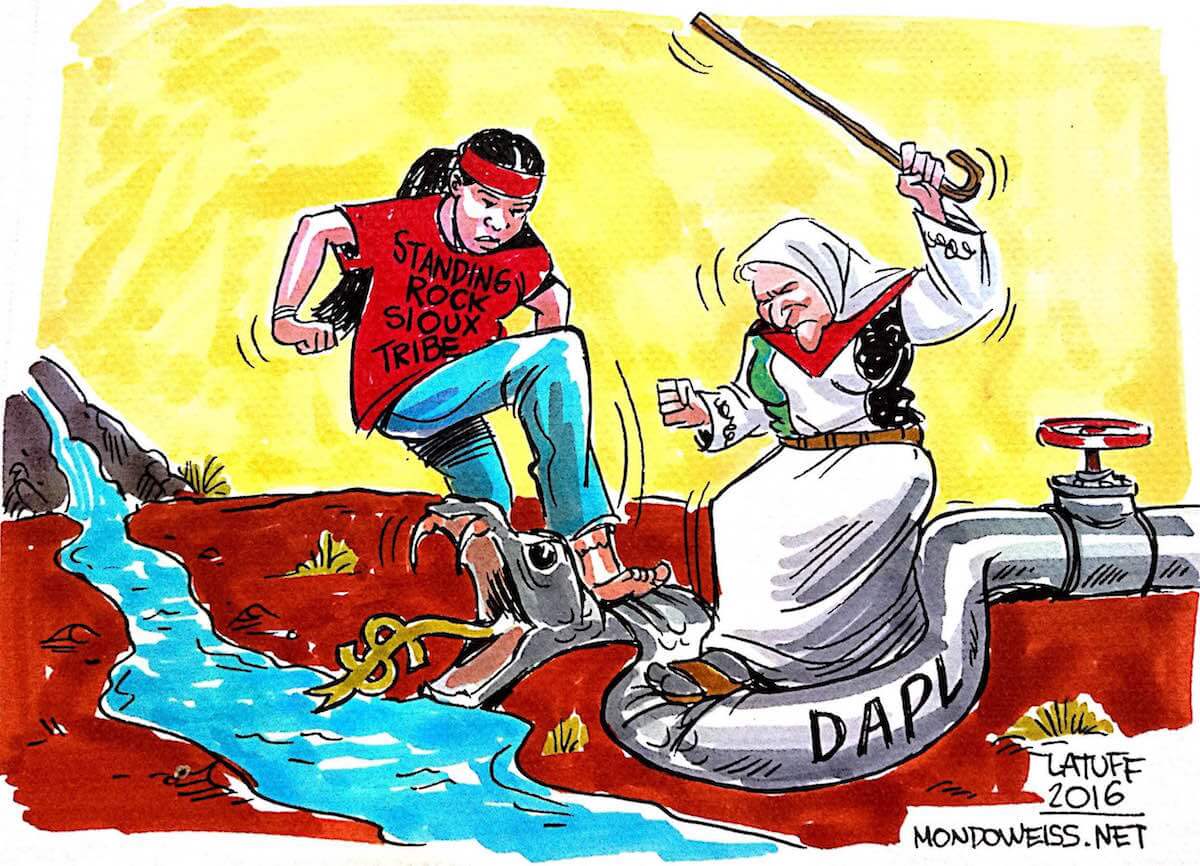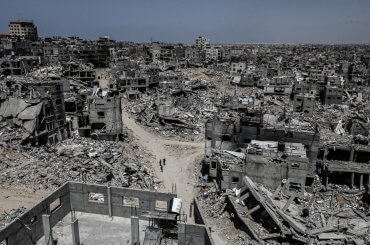Once again, I seem to be glued to my monitor, this time streaming live scenes of the confrontation at Standing Rock in North Dakota. Thousands of unarmed civilians are being attacked by heavily-militarized police and private security, as they seek to protect their lands, their natural resources, their cultural heritage. Succinctly expressing the outrage of many over this latest violation, by the US, of a treaty with of the indigenous nations of this continent, Steven Salaita wrote a post on Facebook that immediately went viral: “The current buildup of tremendous force at Standing Rock should be understood as a military invasion of a sovereign nation on behalf of a foreign oil company.”
And once again, as they have for centuries, the rightful owners of this land are determined to defend it, its life-giving water, its sacredness as a repository of culture. This time, the water protectors are calling for support, solidarity, greater numbers, and thousands of activists are joining them, or sending what they can from widely-circulating lists of supplies. Only very warm coats are needed, and sub-zero temperature sleeping bags. And firewood. Lots and lots of firewood. The water protectors are gearing up for a long standoff, in the bitterly cold North Dakota winter. And people are coming in, from all corners of the country, and beyond.
The Standing Rock Sioux Nation’s defiant resistance to the Dakota Access Pipeline seems to have galvanized grassroots popular support throughout the US, as well as globally. Individuals and groups, many representing indigenous nations, are heeding the call to come, stand with the protectors. I cannot give a blow-by-blow account of what is going on at Standing Rock, as I am not there myself, and the situation is rapidly evolving. (For a helpful and thorough historical context, I found this piece extremely helpful). But I hope I can give some reasons why Standing Rock Matters. And these reasons are not “about us,” they are not about the intersections of our struggles with those of the Standing Rock Sioux.
Standing Rock matters, even if we were not all impacted.

Of course, the intersections between Standing Rock and the struggles and resistance of various other communities are many. Palestinians see ourselves in the Sioux, a long-vilified nation still standing strong against the onslaught of settler-colonialism. “Standing Rock is Palestine,” one friend asserted, as he announced his decision to go to the warrior camp for a second time. Nadya Raja Tannous, who was part of a Palestinian caravan that recently went there from California, wrote eloquently, passionately, about the intersections between the Palestinian and Sioux resistance to settler-colonialism, land dispossession, theft of resources. “Why did I go in the first place? Because somewhere in the awkward power dynamic of being a US citizen, a non-native inhabitant of Turtle Island, and a Palestinian in the Diaspora, I saw the struggle for livelihood and culture, the struggle against settler-colonialism, the struggle to protect the sacred and maintain your own legitimacy, and the ever ominous force of erasure and historical amnesia.” In one of my own OpEds, comparing our Nakba to the catastrophe that befell the indigenous people of this land with the arrival of European settlers, I wrote: “Whatever factors brought Palestinians to live in the USA, speaking of the ongoing Native American Nakba, and creating anti-colonial alliances that better the circumstances of this country’s indigenous peoples, should be the rent we pay, for our stay here.”
BlackLivesMatter also issued a statement, noting the many connections between the two disenfranchised, criminalized communities: “As there are many diverse manifestations of Blackness, and Black people are also displaced Indigenous peoples, we are clear that there is no Black liberation without Indigenous sovereignty. Environmental racism is not limited to pipelines on Indigenous land, because we know that the chemicals used for fracking and the materials used to build pipelines are also used in water containment and sanitation plants in Black communities like Flint, Michigan.”
Climate change activists are also heading to Standing Rock, outraged at the thought of yet one more pipeline potentially poisoning the soil. “It is not a matter of IF a pipeline breaks, it is a matter of WHEN a pipeline breaks. There are no safe pipelines. A spill will threaten drinking water for thousands of people, including the majority of the Standing Rock Sioux Nation. A spill will destroy critical farm lands of North Dakota, South Dakota, Iowa, and Illinois,” one group wrote in their manifesto. For many, the greater concern is not about the violation of Sioux sovereignty, but rather with the national dependence on fossil fuel, and the environmental devastation any and all pipelines cause. The rallying cry seems to be “Keep it [fossil fuel] in the ground,” not “respect indigenous sovereignty and sacred sites.”
But it is indigenous sovereignty, and the Standing Rock Sioux Nation, that matters.
One of the most positive developments in activism over the past few years has been the growth, and widespread understanding of, intersectionality. An intersectional analysis allows us to identify and name manifestations of injustice as we experience them, even as we also acknowledge that our experiences are “similar but not the same” as those of other communities. Thus we stand with communities suffering from the same oppressive system, such as racism, for example, even if the manifestations of that oppressive system are experienced differently, based on one’s perceived race. Grounded in intersectional analysis, Palestinian activists, environmentalists, etc., “see” themselves in/at Standing Rock. But Standing Rock “isn’t” about Palestine. Standing Rock “isn’t” about Black Lives. Standing Rock “isn’t” about climate change. Standing Rock is about all of this, and all of us together. But ultimately, Standing Rock matters because it is about the Sioux Nation, and the indigenous people of this land.
Yes, intersectionality helps us understand, but, as indigenous writer Kelly Hayes points out, “intersectionality does not mean focusing exclusively on the intersections of our respective work. It sometimes means taking a journey well outside the bounds of those intersections.” And Hayes goes on to remind us: “It is crucial that people recognize that Standing Rock is part of an ongoing struggle against colonial violence. #NoDAPL is a front of struggle in a long-erased war against Native peoples — a war that has been active since first contact, and waged without interruption. Our efforts to survive the conditions of this anti-Native society have gone largely unnoticed because white supremacy is the law of the land, and because we, as Native people, have been pushed beyond the limits of public consciousness.”
Indeed, settler-colonialism never ended on Turtle Island, it is ongoing, with daily violations of indigenous rights, and treaties with the sovereign nations. When the water protectors say “water is life,” it is because their very survival is at stake. And as we respond, as we come together from all nations of the globe, we reinforce the bonds of indigenous and transnational grassroots resistance that makes up greater than the sum of our parts. But ultimately, and whatever connections we may make to better understand this standoff at Standing Rock, we must center indigenous concerns in this battle.
Standing Rock is about indigenous sovereignty. As I follow the developments from my home on Salish land, I am humbled by the resistance of the rightful owners of this land, over the five centuries since they were first colonized. Let us center their concerns, their rights, their history, as we stand with them, always, literally, on their grounds.



Standing Rock ~ Palestine. Right on!
If I told that to Hillary Clinton, she’d probably say, “Right, and both lose, as they properly should, to White Supremacist Nations”.
There is something surreal about what is going on at Standing Rock. The Native Americans represent a final, desperate thin line of resistance against ongoing environmental suicide. It is probably too little too late. With atmospheric CO2 at 400 ppm and climbing, and trapped methane a potential accelerant, we have already passed the point of no return, are on the cusp of the tipping point, and will likely soon enter runaway global warming. Yet, our elites plan on adding additional CO2 and methane and other greenhouse gases into the atmosphere. In the elite’s power calculations, apparently survival of the species is an externality. They are so focused on power accumulation that nothing else matters. A quote followed by a link.
” Not only that, but there needs to be ways to start getting carbon out of the atmosphere. Because what’s already in the atmosphere, according to the head of the UN’s environment program, who stated this just about a month before the Paris talks last December—she said that if we stopped all CO2 emissions on a dime right this minute, there’s already enough CO2 in the atmosphere that we’re going to hit 3.5C by the year 2100.” (Dahr Jamail) https://zcomm.org/znetarticle/all-the-warning-signs-are-there-loud-and-clear/
And since there isn’t any chance of stopping all carbon emissions on a dime, we will hit 3.5C (6.3 degrees F) well before 2100. Goodbye ecosystem.
I think the most influential international consensus about the legality of any aspects of colonialism, imperialism, wars of conquest, spoils of war, etc came about first, with the league of nations after WW1, followed by Nuremberg & Tokyo Trials & Geneva IV, following WW2. Israel is the only state currently violating those laws daily, as a matter of continuous policy and conduct. Zionists continually diss criticism of Israel’s activity under said consensus by referring back to the American conquest of the native Americans from Plymouth Rock to near end of 19th Century, as if the world learned nothing at all by two world wars in the 20th Century.
But I bet none of these people will be boycotting America anytime soon. #NIMBYboycott
one night at standing rock talking to 2 young teenage girls, about 16-17, one of them told me her mother said they were invisible to american society and it was their generation (the girls) who were going to make them be seen — not invisible anymore (i told her, your mother is right). it was beautiful. the people there were so conscious, so smart and together. the young people were amazing, and so many kids, so proud and so beautiful.
it blows my mind what they are doing because all of america should be there protecting our water. they should so be leading our country. wow, are we stupid or what.